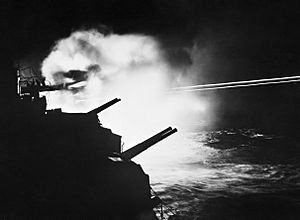Battle of Audierne Bay facts for kids
Quick facts for kids Battle of Audierne Bay |
|||||||
|---|---|---|---|---|---|---|---|
| Part of the Battle of the Atlantic and the Invasion of Normandy | |||||||
 6-inch guns of HMS Mauritius firing during the action in Audierne Bay 23 August 1944 |
|||||||
|
|||||||
| Belligerents | |||||||
| Commanders and leaders | |||||||
| Strength | |||||||
| 1 cruiser 2 destroyers |
10 armed ships | ||||||
| Casualties and losses | |||||||
| None | 8 ships sunk 161 captured |
||||||
The Battle of Audierne Bay was a naval fight during World War II on August 23, 1944. It happened between German ships and Allied warships. Three Allied ships were patrolling near Audierne, off the coast of Brittany, France. They found and sank eight German ships that were part of a convoy. This battle was the final part of a plan called Operation Kinetic. The goal of this plan was to stop German ships and help the Allies who were attacking the city of Brest.
Contents
Why This Battle Happened
By August 11, 1944, a German counter-attack called the Mortain offensive had stopped. To the east, American forces took Argentan on August 13. British and Canadian forces were closing in on Falaise from the north. This led to the plan to surround two German armies in the Falaise Pocket. As the Allies continued to attack ports in Brittany, the main focus of the war moved further east.
The Royal Navy had started Operation Kinetic. Its goal was to clear out German naval forces from French Atlantic ports. Force 27, led by William Davis, was one part of this operation. It included the light cruiser HMS Mauritius and the destroyers HMS Ursa and HMCS Iroquois. They left Plymouth on August 13 to patrol the central Biscay coast. German forces were trying to escape by sea. Operation Kinetic had already been successful twice. It was getting ready for a big naval attack in the Bay of Biscay.
On the night of August 22-23, HMS Mauritius, HMCS Iroquois, and HMS Ursa were patrolling Audierne Bay. Naval intelligence had given them orders. Soon, their radar picked up a large group of ships heading their way.
The Fights Begin
Captain Davis ordered Iroquois, which was closest to the German ships, to use its Type 293 radar. The ship's commander, James Calcutt Hibbard, trusted the radar a lot. He decided to direct the first moves from the ship's Action Information Centre, not the bridge. He then gave the order to light up the area with star shells. This allowed Force 27 to get close without being seen. They launched a surprise attack on what they thought was a convoy of three ships.
At 2:13 AM, Iroquois hit a German flak ship first, setting it on fire. Mauritius's heavy guns quickly destroyed a second flak ship. A third was set on fire and ran aground on shallow waters. In just 19 minutes, all three German ships were out of action. Two were sunk, and the third was burning and stuck.
Second Attack
Two hours later, Iroquois found another group of four ships leaving Brest harbor. This group included an M-class minesweeper, two more flak ships, and a special mine-destroyer ship called a "Sperrbrecher". Force 27 used Iroquois's radar again to follow the convoy from a distance. At 4:08 AM, they lit up the German ships with star shells.
When the British and Canadians opened fire, they quickly overwhelmed the convoy. They sank two ships. The other two ships crashed into each other in the confusion and caught fire as they raced for shore. Crew members jumped overboard to escape. One of these burning ships flipped over and sank. The other hit the rocks at full speed and exploded.
Finishing Up
At dawn, Force 27 continued to sweep Audierne Bay. They wanted to confirm that the German convoy was destroyed. During this sweep, they spotted another minesweeper. They pounded it with gunfire and drove it onto a reef near Port Audierne. Iroquois finished off this minesweeper with a torpedo. Ursa sent a team to board another grounded German ship. They captured eleven prisoners. The other 150 German survivors who swam to shore were captured by the French Resistance. This was the last part of the battle. The Allied force then checked the damage they had caused.
What Happened Next
In total, eight German ships were destroyed that night. These included one minesweeper, one flak ship, five armed trawlers, and the Sperrbrecher. Iroquois alone fired 1,197 rounds from its 4.7-inch guns and 231 star shells. Captain Davis said the success of the battle was due to "some lucky guesses" and the excellent radar and plotting teams on Iroquois. He didn't know it at the time, but secret intelligence, known as Ultra, also helped with those "lucky guesses."
In the last week of August, another naval operation began, called Operation Assault. During this operation, the cruiser HMS Bellona patrolled the Biscay coast. The Royal Navy and Royal Canadian Navy continued these patrols. They sent landing parties ashore in France and on nearby islands. Their goal was to secure these areas and make sure they couldn't be used by Germans for supplies. The blockade of these Biscay ports was very successful, even without land battles.
By the end of Operation Kinetic, the combined Allied naval and air attacks had a big impact. They forced the German navy to reorganize its forces in the fortress ports along the coast.
Images for kids





